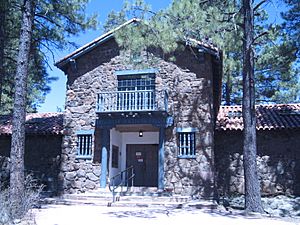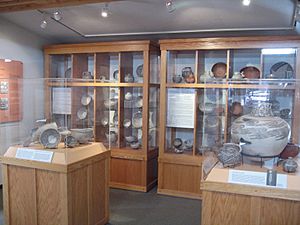Museum of Northern Arizona facts for kids
The Museum of Northern Arizona is a special place in Flagstaff, Arizona, United States. It was created to keep important items from Indigenous peoples and amazing things from nature found on the Colorado Plateau. Think of it as a treasure chest for history and science!
This museum started in 1928. It was founded by Dr. Harold S. Colton, a zoologist (someone who studies animals), and his wife, Mary-Russell Ferrell Colton, an artist. They came from Philadelphia, Pennsylvania. The museum works hard to protect the history and cultures of northern Arizona and the Colorado Plateau.

The museum also has a special place called the Colton House. This is a center for culture and research located outside Flagstaff. The museum is part of the North American Reciprocal Museums program, which means you might get special access if you're a member of other museums!
Contents
Discover the Museum of Northern Arizona
The Museum of Northern Arizona is a fantastic spot to learn about the past. It shows off the rich history of the land and the people who have lived there for a very long time. You can see ancient tools, beautiful art, and learn about animals and plants.
A Look at the Museum's Beginnings
The museum's story began when Harold Sellers Colton and Mary-Russell Ferrell Colton moved to Flagstaff in 1926. Harold was a professor who studied animals at the University of Pennsylvania. Mary-Russell was a talented artist. Together, they helped start the Museum of Northern Arizona in 1928.
Key People Who Shaped the Museum
Harold Colton became the museum's first director. Mary-Russell took on the role of curator for art and ethnology. A curator is like a manager for a museum's collections.
In 1930, another important person joined the team. Her name was Katharine Bartlett. She was an anthropologist, someone who studies human societies and cultures. Katharine came from Denver and became a curator. She worked at the museum for an amazing 51 years!
Growing Bigger and Better
The museum started small, with just two rooms in the Flagstaff Woman's Club. But it grew into a large, private, nonprofit organization. Today, it has a huge Exhibits building that is 24,700 square feet! That's a lot of space for amazing displays.
Next to the main building are facilities for research and storing collections. One special area is the Ethnology Gallery. This gallery focuses on the cultures of the Hopi, Zuni, Navajo, and Pai tribes. You can learn about their traditions, art, and way of life.


